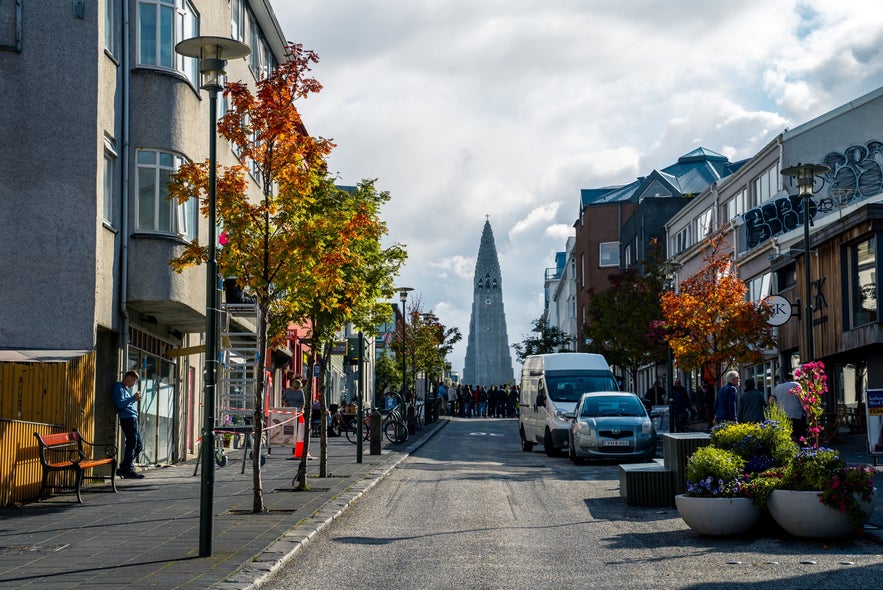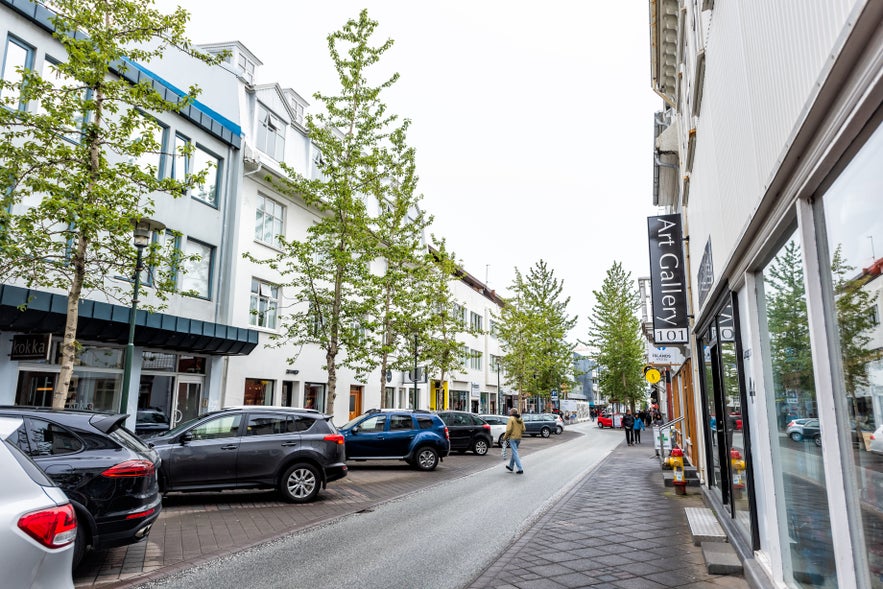
Parking in Reykjavik - Everything You Need to Know

- Reykjavik Parking Zones
- Car Parks in Reykjavik
- Does it Matter in Which Direction I Park?
- Is There Any Free Parking in Reykjavik?
- Hotel Parking in Downtown Reykjavik
- Parking for People with Disabilities in Reykjavik
- How to Pay for Parking in Reykjavik
- Parking Fines in Iceland
- How to Pay a Parking Fine in Iceland
- Parking Outside of Reykjavik

When you arrive in Iceland, ready to explore the beautiful things the country has to offer, navigating parking regulations might not be at the top of your mind. While parking might not be quite as exciting as the northern lights, it's definitely something you need to keep in mind, especially if you plan on staying within the capital of Reykjavik.
Coming down from the stunning panoramic views from the tower of Hallgrimskirkja Church or Perlan to find a parking space can quickly turn a great day into a sour one. For those travelers who are renting a car while staying in one of the many accommodations in Reykjavik, it's a good idea to familiarize yourself with the right way of leaving your vehicles behind before continuing your journey.
This article aims to provide an essential guide to understanding parking in Reykjavik and outside the city. Whether you plan to immerse yourself in city life, embark on a road trip across the island's enchanting terrain, or need to leave your vehicle as you jet off elsewhere, understanding the parking regulations in Iceland is vital.
- See also: Driving in Iceland: The Ultimate Guide to Road Trips
- See also: Travel Etiquette in Iceland
Reykjavik Parking Zones
Central Reykjavik is divided into four parking zones, each with different rates. Parking fees are typically applied between 09:00 - 21:00 on weekdays and Saturdays and between 10:00 and 21:00 on Sundays, with some exceptions (see below).
The four color-coded zones are as follows:
P1 (Red and Pink): The most central and expensive area to park in. The rates here are 600 ISK/hour and are applicable between 09:00 - 21:00 on weekdays and Saturdays and between 10:00 and 21:00 on Sundays.
P2 (Blue): The rates of the blue zone are significantly lower at 220 ISK/hour and are applicable between 09:00 to 21:00 on weekdays and Saturdays and between 10:00 and 21:00 on Sundays.
P3 (Green): The rates of the green zone are 220 ISK/hour for the first two hours, then 65 ISK/hour after that. This applies on both weekdays and Saturdays.
P4 (Orange): Rates in the orange zone are 220 ISK/hour but only apply during weekdays between 08:00 and 16:00.
During certain national holidays, parking within the zones is also free. On these days, you will not be charged when attempting to pay for a parking space, whether you're using a regular parking meter or a mobile app.
Car Parks in Reykjavik
Outside the four different parking zones, several multi-story car parks are located near the city center. These car parks are generally less expensive than the parking zones but charge 24 hours, every day of the week. The rates between car parks can vary, so make sure you know what you're paying before you leave your car there.
Be mindful of the opening times of parking garages as some may be closed overnight, meaning you can get your car stuck in one if you're not careful. This can spell disaster if you need to catch an overnight flight.
Does it Matter in Which Direction I Park?
Yes, be mindful to always park in the same direction as the street's traffic. Parking in the opposite direction of the street may get you fined.
Is There Any Free Parking in Reykjavik?
Parking outside the colored zones is usually free, but remember that certain marked areas may be private. If you ever encounter the Icelandic word "Einkastæði," meaning "Private Parking," you should look for another spot.
Hotel Parking in Downtown Reykjavik
If you're staying in a hotel in downtown Reykjavik, be aware that hotel parking can be limited, and some hotels may not have designated parking spaces at all. This is because the city center was built before the invention of the automobile, making it very compact and walkable, which results in a lack of parking spaces. If your hotel does not have parking included, we recommend using one of the many car parks downtown. Hotels outside the city center usually have more spaces to work with, so be sure to talk to your hotel about parking if you plan on using a car during your trip to Iceland.
Parking for People with Disabilities in Reykjavik
Parking spaces designated for people with disabilities are plentiful in Reykjavik, marked with the international wheelchair symbol. To use these parking spaces, you need to have a Parking Card placed in the front window of your card. Using a Parking Card from outside Iceland is fine, but you must print out and display this notice next to your parking card.
Remember not to park in any space marked with a name or a license number. As some car parks allow a vehicle displaying the Parking Card to park free of charge - check the car park notices or ask an attendant.
How to Pay for Parking in Reykjavik
 There are several ways to pay for parking in Reykjavik. The traditional method is parking machines found throughout the city, usually on every corner of a street within one of the parking zones. These machines accept coins and credit cards, so follow the instructions listed.
There are several ways to pay for parking in Reykjavik. The traditional method is parking machines found throughout the city, usually on every corner of a street within one of the parking zones. These machines accept coins and credit cards, so follow the instructions listed.
The payment methods can differ slightly when using a parking garage, but there will be a similar machine where you can pay by card. Some parking garages charge on entry, while others also allow you to pay upon leaving the garage.
Another convenient way to pay for parking is using a dedicated mobile app. The significant advantage here is paying and extending your parking remotely. EasyPark is an excellent app that allows you to manage parking times easily and uses GPS technology to always know when you're located within a parking zone. Another mobile app option for parking is Parka, which is functionally very similar.
- Read more: Top 10 Apps for Traveling in Iceland
Parking Fines in Iceland
 There are two types of parking citations in Iceland. There are extra parking tariffs imposed on vehicles where paid parking has been insufficiently paid for or not at all, and parking violation charges imposed on illegally parked vehicles.
There are two types of parking citations in Iceland. There are extra parking tariffs imposed on vehicles where paid parking has been insufficiently paid for or not at all, and parking violation charges imposed on illegally parked vehicles.
The standard extra parking tariff is 4,500 ISK, but if paid in full within three business days of the citation, there is a cash discount of 1,100 ISK. If the charge is not paid within 14 days after the citation date, the cost increases from 4,500 ISK. to 6,750 ISK. Charges that remain unpaid after 28 days following the date of citation increase to a further 9,000 ISK.
The parking violation charge is 10,000 ISK and is imposed on a car when stopped or parked under a prohibition sign, on a sidewalk, on a pedestrian street, too close to a pedestrian crossing, or in other situations where parking is not allowed.
If the parking violation charge is paid in full within three business days of the citation, there is a cash discount of 1,100 ISK. If the charge is not paid within 14 days after the citation date, the cost increases to 15,000 ISK. Charges that remain unpaid after 28 days following the date of citation increase to 20,000 ISK. These charges are doubled when illegally parking in a parking space for people with disabilities.
- See also: 24 Things Not to Do in Iceland
How to Pay a Parking Fine in Iceland
If you have received a parking fine, the easiest way to pay for it is to bring the ticket to any of the local banks and pay it there. If you receive a parking fine when using a rental car, your rental provider can match the ticket and charge you if you leave the country without paying the citation. The fees ramp up quite quickly, so the faster, the better. If you believe you have wrongly been issued a parking citation, you can read more about how to appeal the charge here.
Parking Outside of Reykjavik
 Outside the capital, certain locations in Iceland will also require you to pay for parking. The northern town of Akureyri has parking meters for certain areas in the town center. EasyPark and Parka's mobile apps can be used if you're staying in a hotel in Akureyri.
Outside the capital, certain locations in Iceland will also require you to pay for parking. The northern town of Akureyri has parking meters for certain areas in the town center. EasyPark and Parka's mobile apps can be used if you're staying in a hotel in Akureyri.
In rural areas, some parking lots near popular natural attractions are privately owned and will require you to pay for parking, such as Seljalandsfoss Waterfall and Kerid Crater. The rates for these parking lots are typically not very high and are often used to maintain the facilities and trails near the attractions.
When driving around Iceland, it may be tempting to park your car by the side of the road to take pictures. This is not allowed, so only park your car in designated parking lots, which are often just around the corner from your picturesque view.
That's all you need to know when it comes to parking in Iceland. Did we miss anything important? What is your experience when parking in Iceland? Let us know in the comments below!
Inne interesujące artykuły
Islandzki interior | Kompletny przewodnik
Co sprawia, że wyżyny Islandii są tak uwielbiane nie tylko przez mieszkańców, ale też przez turystów? Jakie popularne atrakcje można znaleźć na tych terenach, jakich aktywności można tam spróbować?...Czytaj więcej
Najlepsze zajęcia zimowe na Islandii
Kiedy jest sezon zimowy na Islandii? Co najlepiej robić zimą na Islandii? W jakich zimowych zajęciach możesz wziąć udział? Jakie są najlepsze zimowe wycieczki na Islandii? Przeczytaj nasz artykuł, aby...Czytaj więcej
Najlepszy przewodnik po Złotym Kręgu na Islandii
Dowiedz się wszystkiego, co musisz wiedzieć o niesamowitej trasie Złotego Kręgu na Islandii. Odkryj spektakularne atrakcje przyrodnicze, takie jak wybuchające gejzery, ryczące wodospady i szczelin...Czytaj więcej

Pobierz największą platformę turystyczną na Islandii na telefon i zarządzaj wszystkimi elementami swojej podróży w jednym miejscu
Zeskanuj ten kod QR za pomocą aparatu w telefonie i naciśnij wyświetlony link, aby uzyskać dostęp do największej platformy turystycznej na Islandii. Wprowadź swój numer telefonu lub adres e-mail, aby otrzymać wiadomość SMS lub e-mail z linkiem do pobrania.




















